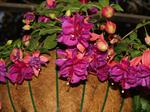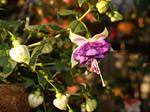A course for Gardeners, Horticulturists, Plant Breeders and anyone else with a passion for Fuchsias

Fuchsias are one of the most popular plants grown thanks to their striking and unmistakable nodding, and often bicoloured, flowers.
There are approximately 100 species, mostly from temperate areas, and more than 15,000 hybrids and varieties. They vary from small trees to shrubs and cascading ground covering plants.
"This is the first correspondence course I have done and I have thoroughly enjoyed it and I just wanted to say a big THANK YOU. I appreciate everyone's effort in such a professionally-run organisation with seamless administration. The office staff's happy can-do attitude, their fast responses to all queries, tutor Shane Gould's quick turnaround in assignment marking and his supportive and motivational feedback and last but not least, the sound subject guides. Most importantly I hope my thanks and appreciation can be communicated to all the staff who have supported me long the way of my learning! I work full time and study on the weekend but really don't stop thinking about what gardening solution I need in order to answer my assignments every day of the week. Thank you for such a great learning experience and I cant wait to start the second half of my course!!"
- Skye
Course Content
1. Introduction
- Nature and scope of Fuchsias
- Plant Naming
- Plant Families, hybrids, varieties, cultivars
- Classification of Fuchsias (Bushes, Shrubs, Standards, Rockery Plants, Espaliers)
- Dividing the genus Fuchsia into seven sub sections
- Describing Fuchsias (Flowers, Foliage, Floral tubes)
- Resources
2. Culture
- Preparing a garden
- Understanding soils
- Plant nutrition
- Planting, staking, mulching, watering
- Pruning
- Pest and disease, etc

3. Propagation
- Scope and nature of Fuchsia propagation
- Propagating mixes
- Potting media
- Fuchsias from cuttings
- Stock plants
- Softwood cuttings
- Hormone treatment
- Semi hardwood cuttings
- Disinfecting cutting material
- Best cutting environment
- Managing pest and disease during propagating Fuchsias
4. The Most Commonly Grown Varieties.
There are over 8,000 Fuchsia cultivars, mostly either derived from F. magellanica and F. fulgens; or derived from F. triphylla or related species. This lesson concentrates on these two groups.
- Hardy Fuchsias
- Upright Fuchsias
- Tall Fuchsias
- Medium growers
- Dwarf Growers
- Trailing Fuchsias
5. Other Important Groups.
- Section 1 Quelusia Fuchsias
- Section 2 Eufuchsia
- Section 2a Ellobium
- Section 3 Kierschlegeria
- Section 4 Skinnera
- Section 5 Hemsleyella
- Section 6. Schufia
- Section 7 Encliandra
- How to train a standard Fuchsia
- Espalier Fuchsias
6. The Lesser Grown Varieties
- Less common characteristics
- Less commonly cultivated species
7. Using Fuchsias
- Using colour properly in a garden
- Container growing
- Topiary
- Hanging Baskets
8. Special Assignment
Problem Based Learning project with the following aims:
-
Identify common fuchsias that are grown commercially and sold in and suited to your region.
-
Identify a range of ‘species’ fuchsias suited to your locality.
-
Identify the cultural requirements of fuchsias suited to your locality
-
Outline methods for producing ‘exhibition quality’ fuchsias.
Course Duration - 100 hours of self paced study
 How Did We Come to Love Fuchsias so much?
How Did We Come to Love Fuchsias so much?
The name Fuchsia was given to these plants to honour a 16th century botanist called Dr Fuchs who is regarded as one of the founding fathers of botany. The discovery of the plant itself is attributed to Dom Charles Plumier, a French scientist, in 1696 who named it after Fuchs. Fuchsia plants are mostly indigenous to Central and South America, with some species occurring naturally in parts of the Pacific.
The first detailed description of a fuchsia was published in 1703 and the first fuchsias were introduced to European cultivation in the 1780’s. These first introductions were F. magellanica and F. coccinea. Other species including F. arborescens, F. fulgens and F. microphylla were introduced not long after.
Fuchsia hybrids were first reported to be bred in 1825 (between F. arborescens, F. coccinea and F. macrostemma). Fuchsias are today one of the most hybridised genera in the horticultural world.
Many of the Fuchsia species are native to cloud forests in the Andes, and adapt well to temperate gardens around the world. Most of those from the tropics will occur naturally at higher altitudes in wet forests. Some are more suited to subtropical or cooler temperate areas than others; but most are grown in places where summer humidity does not get excessive and winter frosts are not extreme.

The majority of cultivated Fuchsias tolerate temperatures to around freezing point, and many species can withstand lower temperatures than this under certain conditions. Some will have foliage damaged by frost or cold, but the root system can remain unaffected and the plant can regenerate even after the top has been devastated. Some are deciduous and may withstand more extreme cold after the leaves have dropped.
Today there are people who devote their entire lives to fuchsias; some earn a living propagating and supplying fuchsias from a specialist fuchsia nursery; others are plant breeders who derive much of their income from breeding new fuchsia cultivars. Fuchsia societies operate in the UK, Australia and many other parts of the world, and garden writers are always producing articles and books about fuchsias. Even if your interest in horticulture is not dominated by fuchsias; this is one of a relatively small number of genera that is widely cultivated in gardens around the world; and as such; every practicing horticulturist can benefit from a more in depth knowledge of the genus Fuchsia.

WHAT NEXT?
Register to Study - Go to “It’s Easy to Enrol” box at the top of the page and you can enrol now.
or
Get Advice – Email us at info@acsedu.co.uk OR
Use our FREE COUNSELLING SERVICE to contact a tutor
CLICK TO CONTACT US